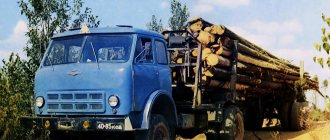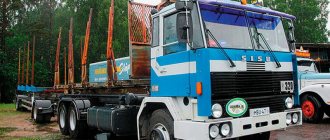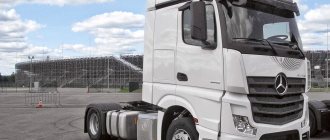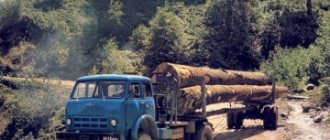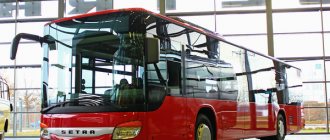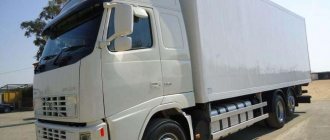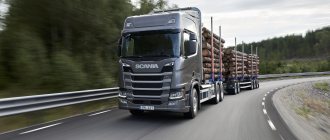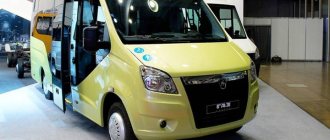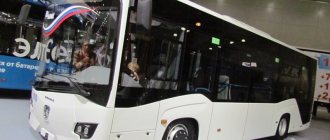Skåne County is the southernmost and most forested region of Sweden, from which the name of the automobile company widely known for its indestructible tractors comes from.
These northern vehicles bear not only a heavy load, but also the burden of people's love, because Scania timber trucks are the most representative family of tractors, after the traditional inhabitants of Russian forest roads - URALs and MAZs. It’s no joke, about 40 thousand tractor units of the Swedish company travel on our unpaved “one-lane” roads, although Scania’s main competitor, Volvo timber trucks, is not far behind them. Let's try to understand the reasons for such a serious expansion into the domestic market, the advantages and disadvantages of Swedish products over Russian ones.
Why you need to buy Scania timber trucks:
- Because the climatic conditions of Sweden correlate perfectly with those of Russia, and it is the temperature regime that becomes a stumbling block for most examples of Western thought exploited in our country. The roads on which Scania timber trucks are tested are also far from ideal, as are our routes for transporting logs. Difficult operating conditions in its home country allow us to say that Scania is a timber carrier that is maximally prepared for difficult domestic roads.
- No less than our timber harvesters, our Swedish colleagues are familiar with their industry: in the northern countries, Scania and Volvo timber trucks occupy leading positions, and the volume of timber coming from these countries to the rest of Europe is in no way inferior to the Russian scale. Cars made in China, Brazil or even Turkey (see Mercedes Axor) are simply not able to withstand any competition with these tractors. Their trump card lies elsewhere.
Unlike its main competitor from Sweden, the Volvo concern, Scania timber trucks are not yet assembled in Russia, which is why they are inferior to Volvo in price.
- Good familiarity with logging, cooperation with companies involved in the production of related special equipment. technology allowed the Swedes to create not just individual models of log and log carriers, but a whole range of services. In fact, the buyer can create a turnkey machine himself by ordering the necessary superstructures for a timber truck (Alucar, Sisu, DOLL Fahrzeugbau) and manipulators (HiabLoglift, Liebherr, Kesla), choosing the necessary equipment, chassis, etc. Almost all Scania models are adapted for timber trucks, therefore, on the basis of any of them, the buyer can assemble the equipment he needs, saving on unnecessary options, horsepower, etc.
- The fourth reason why you can buy a Scania timber truck and not regret the purchase is fuel consumption. Comparing the engines of KamAZ and Swedish competitors, one can notice disappointing characteristics for a Russian tractor: for the same fuel consumption, the products of the Kama Automobile Plant have an engine of 260 hp, while Scania has 500. The difference is obvious.
- The opposite is also true: with the same power, the Swede’s fuel consumption will be noticeably lower. Load capacity, with the same consumption characteristics, is not at all in favor of Russian products - by 500 hp. the Scania timber carrier accounts for 24-26 tons, i.e. 2.5 times more.
There is no universal solution for transporting timber, partly due to restrictions in Russian legislation, but 24-meter Scania timber trucks can be seen in our country.
Review of popular models
The most popular timber trucks of the Scania brand belong to the R, G, and P series lines and each have their own distinctive features:
- The R models are the most powerful of the three. These include 700-horsepower timber carriers used for long-distance transportation of goods. The most in demand among them are international transporters with a power of 420-500 hp.
- The P series provides more compact special units with high maneuverability, used for domestic and urban transportation of relatively light loads.
- G represents the “golden mean” between the other two lines, since with relatively smaller dimensions it can be used for transporting heavy long items both at the regional and international levels.
Photo of timber truck Scania P-440
145
This model was created on the basis of the first generations of Scania trucks, produced in two versions - L with a 4 * 2 wheel arrangement and LT - 6 * 4. Their advantage is the possibility of large loads on the front and rear axles. They are still in demand due to the extraordinary reliability of the design and the free possibility of modernization.
Technical characteristics of the Scania 145 timber truck:
| Characteristics | Indicators |
| Total weight, kg | 32000 |
| Engine, power/volume, hp/l | 350/14 |
| Wheel formula | 4*2, 6*4 |
| Suspension type | spring |
| Transmission | Manual transmission |
| Base length, mm | 3400 |
| Fuel tank volume, l | 300 |
| Load capacity, t | 20 |
R 500
R-500 is included in the R series of heavyweights, produced by the brand's enterprises since 2004. It is distinguished by the highest engine life (1000 thousand km), a cabin high off the ground and ergonomic design.
The power units of these machines have a V-shaped arrangement of 8 cylinders, and the transmission has 12 steps.
Technical characteristics of the Scania R-500 timber truck:
| Characteristics | Indicators |
| Total weight, kg | 34500 |
| Engine, power/volume, hp/l | 500/15,6 |
| Wheel formula | 6*4 |
| Suspension type | combined |
| Transmission | Manual transmission |
| Base length, mm | 4700 |
| Fuel tank volume, l | 450 |
| Load capacity, t | 26 |
Video review of the Scania R-500 timber truck:
R 580
This powerful model has a compact design, which allows it to be used for large shipments as part of a road train. The vehicle's suspension is combined (using springs and 4 cylinders), the frame is equipped with removable sides, allowing you to transport cargo without packaging. The special comfort of the cabin is complemented by a high-performance dual-telescope manipulator.
Specifications:
| Characteristics | Indicators |
| Total weight, kg | 40910 |
| Engine, power/volume, hp/l | 580/16 |
| Wheel formula | 6*4 |
| Suspension type | combined |
| Transmission | Manual transmission |
| Base length, mm | 3300 |
| Fuel tank volume, l | 450 |
| Load capacity, t | 16 |
Photo of timber truck Scania R-580
G 440
The main advantages of this machine are that it is equipped with a heavy-duty engine with a modernized gearbox, the operation of which is aimed at saving fuel. At the same time, working on the machine is complemented by the special comfort of the cabin design - heated seats, a berth, a sun canopy and fog lighting. Most systems are electronically controlled.
Technical characteristics of the G-440 model:
| Characteristics | Indicators |
| Total weight, kg | 28300 |
| Engine, power/volume, hp/l | 440/12,7 |
| Wheel formula | 4*2 |
| Suspension type | combined |
| Transmission | Manual transmission |
| Base length, mm | 3400 |
| Fuel tank volume, l | 700 |
| Load capacity, t | 30 |
Photo of timber truck Scania G440
P 440
These machines are equipped with Finnish timber superstructures with a reinforced frame and a power unit powered by 6 cylinders.
The monitoring system allows you to control the equipment in action even online, and the gearbox greatly simplifies control thanks to the presence of 12 gears and reverse speed.
Technical characteristics of the P-440 timber carrier:
| Characteristics | Indicators |
| Total weight, kg | 34500 |
| Engine, power/volume, hp/l | 440/13 |
| Wheel formula | 6*4 |
| Suspension type | combined |
| Transmission | Manual transmission |
| Base length, mm | 4200 |
| Fuel tank volume, l | 450 |
| Load capacity, t | 8,5 |
In the video, a Scania timber truck with a manipulator in action:
Why Scania timber trucks are not worth buying
No matter how versatile the Swedes offer, the price tag for their products is so steep that it’s time to mortgage real estate to buy a “home on wheels.” There are also restrictions on the minimum configuration, i.e. savings on unnecessary options cannot be endless and some part of the car will have to be purchased even without direct need. And the price for the minimum configuration of a new Scania timber truck is around 5 million rubles. For comparison, the above-mentioned KamAZ (model 44108) is valued by the plant at 1.7 million rubles, i.e. three times cheaper.
More on the topic: GAZ 330811 “Vepr” - a universal SUV
Simplifying, we get that Scania is a timber carrier that transports twice as much as a Russian tractor, but costs three times more. At the same time, in Sweden, native to these timber trucks, the use of road trains up to 25 meters in length has long been permitted. The maximum weight of the machine is 60 tons. Russian standards are noticeably stricter and most of the solutions prepared by Scania specialists are not suitable for our country, because a powerful tractor simply cannot fully demonstrate its characteristics here.
As you can see, the advantage of Scania is not so obvious and the devil is in the details. The most acceptable and most often used as a timber truck is the R series. Let's take a closer look at these Scania timber trucks.
Timber trucks Scania: R—series
The R line has been produced by the Swedish concern since 2004, although the presentation of the car took place a little earlier. Already in 2005, the new product received the title of best “Truck of the Year”. The international jury noted the work of the creators to reduce weight, the highest reliability of all vulnerable and wear-prone components (the engine life was estimated at 1000 thousand km), the excellent performance of the truck, coupled with the preservation of the traditional features of Scania tractors. Feedback from drivers indicates significantly improved ergonomics of the workplace compared to the previous Erke 4 Series.
The names of new Scania tractors follow a simple formula. The cabin type is determined by the first letter (P, R and G), the following numbers indicate the engine power in hp. (previous, 4th series of tractors - engine size, first two digits, third - family index). The letter after the numbers means the purpose for which the vehicle was designed (L - long-haul tractor, C - quarry, construction, D - delivery equipment). After the destination index, the type of vehicle (chassis or truck tractor - B and A) and wheel formula are indicated. These are followed by work severity conditions (from light to heaviest - M, H, E), chassis height (in descending order - H, N, L, E) and suspension type (all spring, all air, air rear and spring front - Z, B, A).
In the spacious cabin of the Scania R timber truck you can stand up to your full height.
Type R cabs were designed for long-distance transport (for example, international transport) and operation in harsh conditions. When compared with the P series, the R-cabins are distinguished by their high height above the ground (for example, the roof of the CR16 is located 310 mm higher than the CP16, which means there is another step for the driver). The space has been expanded by reducing the tunnel (by 15 cm).
The R-series also has improved ventilation and allows for several fundamentally different configuration options. The ultra-comfortable Highline and Topline variants have room for even several oversized passengers: the height of the latter is 2230 mm, the Highline is 1910 mm. Single and double bedroom configurations are available.
Power units of Scania timber trucks
The R series is distinguished from other Scania trucks by its eight V-shaped cylinders. This is a serious request and the characteristics of the engine correspond to it, because when creating the engine, Scania designers used all the best developments over the last decade and modernized all the old components. The most famous representative of the line is the 16-liter DC 1604 diesel engine with a power of 580 hp. and a torque of 2700 Nm.
More on the topic: “Gazelle” van
In addition to the 8-cylinder representatives, standard 6 cylinders are also used. These are 11-liter diesel engines DC 1108 (1600 Nm, 430 hp) and DC 1109 (1800 Nm, 380 hp) and their older brother DC 1214 developing up to 420 hp. (470 with modifications) and 2100 Nm of torque.
Modern variations of power units demonstrate power up to 700 hp. and all of them are the pride of the company. Efficient and durable injectors, the famous turbocompound system and multi-stage gas recirculation are just the tip of the iceberg. All R-series trucks are equipped with electronic units connected by a multifunctional CAN bus, which allows the automation to quickly find faults and adjust the operation of the engine and suspension in the direction of travel.
The dashboard of the Scania R is lined up perfectly, and there is even room on the side for a coffee maker.
The engine communicates via the electronic bus with the Opticruise automatic transmission, which reduces fuel consumption to a minimum. Nitrogen oxide emissions are reduced due to the introduction and improvement of the Selective Catalytic Reduction system, which mixes urea and clean air in the catalytic converter. Together with gas recirculation, this makes it possible to maintain a highly environmentally friendly vehicle and fit into the difficult standards of future Euro standards.
Scania PDE is an injection and fuel injection control system, the company’s own development. Installed as standard and allows you to equalize and reduce fuel consumption
R-series chassis
There are two main variants available - 6x4 and 8x4 chassis with different suspension options. A unique offer for a timber truck is a 4-balloon air suspension. Thanks to its low weight, Scania timber trucks carry more cargo and consume less fuel. Springs are installed at the request of the buyer, and the Swedes themselves tend to opt for spring or combined suspension due to the possibility of breaking the chassis on air springs (in the absence of rigidity, the driver forgets to reduce speed).
The 12-speed transmission allows you to accurately dose loads and perform complex maneuvers. The safety margin of this unit is such that, according to statistics from service centers, only a few cars require transmission repairs, despite decades of operation.
All timber trucks are equipped with retarders of our own production. The standard power of the Scania retarder is 4100 Nm. This brake is enough to stop even an overloaded tractor.
In addition to the standard wheel formulas 4x2, 6x2, 6x2 with two steered axles, 6x2 with a rear steered axle and 6x4, Scania offers to assemble a timber truck on “non-standard” four-axle vehicles 8x2, 8x4 (1 and 2 steered axles) and on all-wheel drive 4x4 and 6x6.
Reviews from Scania timber truck owners
Andrey, Petrozavodsk. Scania R500, mileage 800 thousand km.
I was choosing between a Man with low mileage and a Scania tractor under lease (500-600 thousand mileage). I had no doubts about the logging orientation of this machine; my experience with Swedish machines was positive. But at the same price, Scania had almost twice as much mileage and was used in extremely difficult conditions. The characteristics spoke in favor of the Swede: it carries 40% more, the consumption is not much, but it is more economical. I chose the Scania timber truck and was right. Despite the high mileage, I didn’t notice any serious breakdowns in the first year and a half, although now we are going to replace the light Alukar conics with Titan 10.
Rustam, Ufa. Scania R620, mileage 220 thousand km
This is the first Scania in our company. Our fleet already has a MAZ-6303, two Ural-375, etc. Getting to know Swedish machines was a revelation: we decided to buy a Scania timber truck with a Kesla superstructure and an Alucar manipulator. Everything has been done here for the driver: the workplace has been checked to the smallest detail, furnished indecently richly. Dynamics, acceleration, handling - everything is at its best. Xenon headlights. I will note the possibility of automatically turning on the retarder when going downhill (it is adjusted to exceed a certain speed threshold). The only damage so far is a broken spring, which I attribute to the heavy front axle. If we continue to move without serious breakdowns, we will recoup the purchase in a couple of years.
Design features
The main feature of these timber trucks is the presence of a manipulator, which allows one machine to handle both transportation and loading of timber of different lengths and weights. The manipulator is a complex mechanism, powered by machine hydraulics and having several degrees of freedom for ease of spatial control of loading long items.
Scania presents the following design features to the consumer:
- Equipped with power units with an established power rating from 230 to 620 hp, as well as the real pride of the company - engines with power up to 700 hp.
- The Scania PDE injection and control system from the company’s own designers allows to reduce fuel consumption.
- 12-speed transmissions with overdrive or clutch protection to increase machine life.
- Chassis can have different initial configurations - full or partial drive (6*4, 8*4), variations in axle configurations, individually selected frame height and type of suspension - leaf spring or combined, with the addition of air springs.
- High maneuverability and precision dosing of loads on the front and rear axles are ensured by a 12-speed transmission.
- Availability of an electronic unit for automatic control, testing and adjustment of suspension and engine systems.
- The latest Selective Catalytic system also makes the car environmentally friendly, as it neutralizes nitrogen oxide emissions into the atmosphere during engine operation.
- The spacious cabin is equipped to meet all the requirements for operator comfort.
INTERESTING! All Scania timber trucks are equipped with retarders of their own production, ensuring traffic safety even with a faulty braking system.

